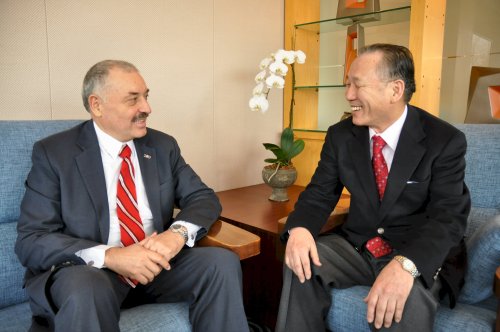No matter the riches and opportunities Paraguay offers, the growth of this Latin American country’s export industries is hindered by its location.
A landlocked country, Paraguay’s plan to become a regional hub for Asian products relies heavily on its main waterway, the Paraguay River, the backbone that connects Brazil, Bolivia, Paraguay, and Argentina to the vital shipping lanes of the Atlantic Ocean.
“We need to improve our waterway, it’s something very important,” said Paraguay Ambassador Ceferino Valdez concerning plans to attract Korean construction companies in the future dredging projects proposed by the nations of La Plata Basin.
In 1997, the governments of Argentina, Brazil, Bolivia, Paraguay and Uruguay proposed to develop the river into an industrial waterway system to help reduce the costs of exporting goods from the area such as soybeans from Paraguay, lithium from Bolivia, cereals from Argentina and iron from Brazil.
The Hidrovia project is considered to have extremely positive effects for these countries that rely heavily on expensive land and air transportation to move their resources.
A landlocked country, Paraguay’s plan to become a regional hub for Asian products relies heavily on its main waterway, the Paraguay River, the backbone that connects Brazil, Bolivia, Paraguay, and Argentina to the vital shipping lanes of the Atlantic Ocean.
“We need to improve our waterway, it’s something very important,” said Paraguay Ambassador Ceferino Valdez concerning plans to attract Korean construction companies in the future dredging projects proposed by the nations of La Plata Basin.
In 1997, the governments of Argentina, Brazil, Bolivia, Paraguay and Uruguay proposed to develop the river into an industrial waterway system to help reduce the costs of exporting goods from the area such as soybeans from Paraguay, lithium from Bolivia, cereals from Argentina and iron from Brazil.
The Hidrovia project is considered to have extremely positive effects for these countries that rely heavily on expensive land and air transportation to move their resources.

Once completed, the lower cost of transportation would make the region more competitive while spurring economic growth and jobs in the area.
Paraguayan Chamber of Commerce in Korea’s CEO Lee Hang-soo sees great potential for the future once the project is completed.
“Once Paraguay becomes a strong enough export-oriented country, then Korean companies will also grow because many of our exports will be delivered to several MERCOSUR (Southern Common Market) countries,” Lee said. “Paraguay would become a hub.”
Both Valdez and Lee noted that the framework for the business future of both countries has been in place since it was laid out by the countries’ two presidents. The challenge now is getting companies on both sides to move forward.
Both countries’ bilateral trade rests on widening of the Paraguay River and the developing industries involved with shipping.
“The logistics cost to export products out of Paraguay is really high and that makes it not competitive enough to export,” Lee said. “We have been talking with our government for them to participate in the dredging of the river so that we can grow together.”
Lee said that one plan for the future bidding of Hidrovia is to break the overall project into four parts.
The plan would see four separate Korean companies responsible for the dredging of the 2.6 kilometer river.
Lee is not going head first into the plan. First and foremost, the growth of Paraguay’s future in relation to the size of the project needs to be further examined.
“Right now we have to think beyond 10 years,” he said.
Valdez added, “It’s a big job. It involves many countries and the river is big.”
By Yoav Cerralbo (yoav@heraldcorp.com)












![[Today’s K-pop] BTS pop-up event to come to Seoul](http://res.heraldm.com/phpwas/restmb_idxmake.php?idx=644&simg=/content/image/2024/04/17/20240417050734_0.jpg&u=)




![[KH Explains] Hyundai's full hybrid edge to pay off amid slow transition to pure EVs](http://res.heraldm.com/phpwas/restmb_idxmake.php?idx=652&simg=/content/image/2024/04/18/20240418050645_0.jpg&u=20240418181020)

![[Today’s K-pop] Zico drops snippet of collaboration with Jennie](http://res.heraldm.com/phpwas/restmb_idxmake.php?idx=642&simg=/content/image/2024/04/18/20240418050702_0.jpg&u=)